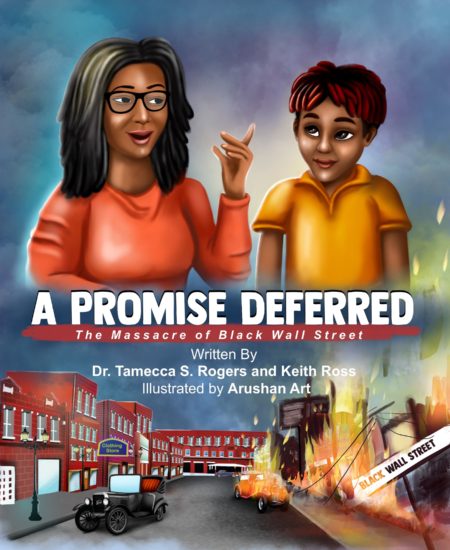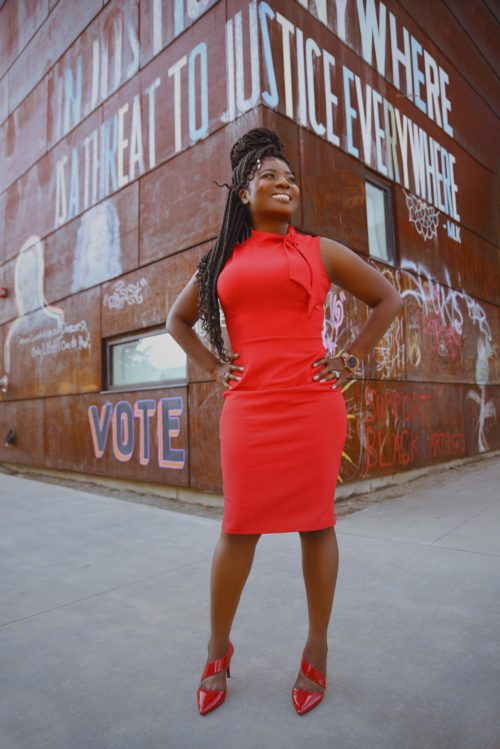Dr. Tamecca Rogers- A Promise Deferred: The Massacre of Black Wall Street
Community News, News — By Buddy Sampson on May 27, 2021 at 11:00 pmHow do you explain the inexplicable to a child?
By Buddy Sampson
Having to explain senseless, horrific events to a child is one of the most daunting prospects a parent ever has to experience in their lifetimes. To explain the inexplicable, to explain to a child the inhumane acts committed by a segment of one population on another, while in many ways personally processing the effects of those acts, which continue to present day, is a nightmare much of world’s population will never experience.
Dr. Tamecca S. Rogers has attempted to tackle this nearly impossible prospect in her writings with her son Keith Ross, “A Promise Deferred, The Massacre of Black Wall Street.” The book, crafted for children, presents, with illustrations by Arushan Art, a vivid picture of the senseless tragedy that took place in 18 hours between May 31st and June 1st in Tulsa, Oklahoma.
In the acclaimed children’s book, Keith’s Grandme tells him about the events of May 1921. The book starts with some of the colorful characters and business owners who once graced the Greenwood District. Throughout the story, Keith is both horrified by what happened and proud of how Black people created this business district. He is also inspired to learn how they helped one another. Presented in easy-to-follow language catered for children, “A Promise Deferred” attempts to explain the inexplicable.
The anniversary- a series of events that took place on those two days, in an area called Greenwood, a thriving Black town, known as Black Wall Street, where there were successful entrepreneurs and businesses, included lawyers, real estate agents and doctors. Many African Americans had migrated to Oklahoma to escape the vicious killings and lynchings in the South and also to take advantage of “quick economic gains through the mining and oil industries,” according to the American Journal of Economics and Sociology, “The Destruction of Black Wall Street: Tulsa’s 1921 Riot and the Eradication of Accumulated Wealth. (Chris Messer, Thomas Shriver, Alison Adams).” African Americans were so prosperous it caused resentment from their white neighbors who felt they, in many ways, were overstepping their boundaries. When police arrested 19-year-old Black shoe shiner Dick Rowland, accused of assaulting 17-year-old white elevator operator Sarah Page, in an incident in which he simply tripped in the elevator, white mobs were attempting to lynch Rowland.
However, a group of 75 Black residents, some of them armed, refused to allow his lynching. When one of the members of the White mob tried to disarm one of the Black residents, a firestorm began in which 10 Whites were killed along 2 Blacks. The sheriffs deputized many of the White residents and they leveled the town, killing as many as 300 people, ruining businesses, churches and homes, destroying any prospect of rebuilding Greenwood. In those fateful hours, Black Wall Street in Tulsa, Oklahoma, Greenwood, a thriving black town, suffered the horrors of racism and the specter of the murders of hundreds of African-Americans, destroying their businesses and, with the acts that took place over those two days, the generations that followed the massacre, their descendants, have lost the prospect of generational wealth, all from the acts of horror that on took place on those days, having reverberating effects on the Black community for decades and decades.
During 2020 and because of isolation due to Covid-19, Dr. Rogers and her son Keith worked on the book. “This is something that we’ve done because we’ve been in the house together,” laughed Dr. Tamecca Rogers, who holds a bachelor’s degree in psychology, a master’s in business administration and a doctoral degree in educational leadership. “In his school they don’t teach some things and there are a few things that I didn’t learn in school as well.” Indeed, much of the events that have occurred in African American history are rarely, if ever, taught in schools. Dr. Rogers and Keith worked diligently during the pandemic to address that issue.
“We ended up writing 7 books during the pandemic, and that was one of them,” said Dr. Rogers, who additionally served five years as a hospital corpsman in the United States Navy and a combined six years as a high school instructor and college enrollment counselor.
However, how do you explain racism and violence to a child? What can be done to preserve their innocence? “That’s the hard part,” said Dr. Rogers. “I wrote another book, ‘Does My Life Matter,’ and it’s a children’s book. With Keith going to school and his friends saying, ‘no, all lives matter,’ so for me it was necessary to explain that to Keith, so he can articulate that as well.” Because of being isolated much of the time due to Covid-19, Dr. Rogers, Keith and her other children were, as much of the country, inundated by the news media with the reports of the death of George Floyd.
“My kid is actually watching the news with me and we’re seeing this unfold in front of our face. As a parent, I thought, ‘I have to have the talk with you,’ “said Dr. Rogers. Virtually all African-Americans have had to have “The Talk” with their children, explaining in the best way they can, the inequities of society and violence, often unprovoked against men, women and children of color. “I’ve already had the talk with my older sons that are 24 and 19,“ she explained. “With Keith, I had the talk, but it was just like a gloss over the talk. I had to go a little deeper as we watched these things unfold (with George Floyd). For me it was hard, as a mom, because George Floyd was calling out for his mom. I was like, where would I be when my son is in trouble, when things like that happen and I can’t protect him. It’s hurtful, because you do believe you’re taking away from their innocence. It was difficult for me, and since I knew how difficult it was for me, I figured we should write a few books about it to help other people explain it a little better.”
Dr. Rogers has written several stories with her ten-year-old son, Keith, including Now You’re It: Journaling to Perseverance, which celebrates the achievements of 35 groundbreaking people of color from the past and present. She also wrote Daddy, Can I Decide?, a picture book about allowing every child to determine their own future, and Mommy May I Be Me?, a story that creates awareness of how young minds develop while encouraging parents to be more open-minded and accepting of their children’s sound decisions. She also wrote the children’s book Girls Can Be Anything with her eight-year-old cousin London Love. The book looks at the lives of four little girls on Inauguration Day and their reaction to Kamala Harris’ achievement in becoming the first black woman vice president of the United States. Finally, Cornrows: My Hair, My Roots, is a children’s book that details the cultural and historical significance of cornrows and locks in modern American culture.
Born in Coffeyville, Kansas, Dr. Tamecca Rogers has resided in Tulsa, Oklahoma most of her life, since she was in second grade. “It’s crazy that we have to pass Oklahoma history to graduate from high school and none of that (The Massacre of Black Wall Street) was in the history books,” she said. “And what’s crazy about it is that people that lost their homes and their businesses were never compensated for it.”
One of the biggest tragedies of The Massacre of Black Wall Street, and many of the tragic occurrences against people of color is the lack of historical transparency. Black history, and especially violent attacks and atrocities are rarely, if seldom recorded in the history books. “It’s just not in the State-mandated curriculum,” she explained. “What I told my son is, is that you’re responsible for learning. It’s up to us as parents, adults and children to reach in, dig in and to learn what we can of our history and not let somebody else tell us what our history is.”
Dr. Tamecca Rogers has also held adjunct professor positions at multiple postsecondary institutions. Dr. Rogers has worked at Tulsa Technology Center since 2010 and currently holds the position of the director of diversity, equity, and inclusion. She is the proud mom of Ian, Chazen, and Keith and lives in Tulsa, Oklahoma, with her family.
A Promise Deferred: The Massacre of Black Wall Street by Dr. Tamecca Rogers; Illustrated by Arushan Art; Inspire Publishing LLC; Juvenile Nonfiction; History/Body, Mind, & Spirit; Paperback 978-1-7354301-8-8 $14.73; eBook Kindle $2.99; Availability: Amazon.com.






 Tweet This
Tweet This Digg This
Digg This Save to delicious
Save to delicious Stumble it
Stumble it




